(Wordy one today, so cozy up with a glass of something tasty and indulge me for a little while longer than usual!)
Scandinavia is an area of the world that continues to fascinate me, mostly because I really know very little about it. First of all, I'm not even really sure if Scandinavia is the right term or not. Nordic Countries? Europe's hat? Anyways, wherever it is I don't know a great deal about Scandinordicia. I mean, I know where it is and everything, I know all their flags are roughly the same, and that their climate, social mores and way of life are more in line with us in Canada than most other countries in the world. Their GDP/GNP, press freedom index, and development are all among the world's highest, and they usually kick some serious ass in the Winter Olympics. Our languages are somewhat on the same team, even though it doesn't really sound this way; the English language is in the same Germanic language family as all the Scandinavian countries save for Finland, and with the Norse influence on England's development more than 1000 years ago, many of our words have Norse ancestry.
And yet, for an area of the world so similar in many respects to Canada, there are such striking differences from our own country as well, and I'm ashamed to say I don't really know what's going on up there. There is indeed a whole history of Northern Europe that is an utter mystery to me, with the Swedish Empire of the 18th century and the union of Denmark and Norway, and later between Norway and Sweden, and all sorts of developments along the way. Other than the names of the capital cities and a few other places, I couldn't name more than five cities in any of the Scandinavian countries, let alone the provinces or regions. Apparently, Sweden and Denmark have been on opposing sides in warfare more times than England and France. And then there is the language, or languages I should say, that while similar to ours in some respects sound unlike anything I have ever heard, with their secret letters and dots and umlauts and strikethroughs. I'm reminded of something Bill Bryson mentioned in
In a Sunburned Country, his travel journal through Australia. He muses that Australia is a mystery to North Americans, not necessarily because of its isolation, but instead because they just don't come up in the news very often. He observes that Australia is mentioned less in the New York Times over the course of a year than some celebrities are; we really don't know what's going on their either. Because Scandinavia, like Australia, seems to have its act together and is politically stable, it means that we don't hear about them very much on a day to day basis (save, of course, the tragic attack in Norway last year). It's like the "no news is good news" policy; we don't need to call them every week to make sure they're okay. We see them every few years at the Olympics or a hockey competition, and that's about it. We really should invite them over more often, cause they seem like good people.

I have to say, however, that this year has been a real Scandinavia awakening for me, as more and more pop culture and history from the region has come to my attention, and the rise of Scandinavian craft breweries has certainly had something to do with this. It started off with the N
ørrebro brewery release last winter, which first exposed me to the Danish craft brewery scene; shortly after this, a friend of mine visited Iceland and had some amazing pictures of parks, villages and weird dishes he was subjected to. Then there is the highly entertaining and educational webcomic
Scandinavia and the World, in which the nations of the world are personified as adorable little cartoon characters with flags for shirts (Canada is the well-meaning, but rarely-listened to buddy of the USA, a beefed up loudmouth who confuses and frightens the Scandinavians with his overt religiosity). True to the title, much of the humour is derived from the relationships between the nations of Scandinavia. Norway seems to be the straight man, next to fastidious and dignified Sweden (whom everyone always makes fun of), frat boy Denmark, silent Viking metal music-listening Finland, and Iceland, who apparently is just insane. What really makes this strip work for me is the fact that the creator explains the situation at the bottom of the strip, which really does teach you a great deal about what goes on in the area. One such comic,
this one, directed me to a Youtube video from Kollektivet (a sort of Norwegian "Lonely Island", I guess), in which the duo boast about how, despite Americans' achievements, they can suck it, because Norway has the bigger alphabet. It's pretty funny, I have to say, and it had the dual function of getting me interested in the Norwegian language. Just a few days ago, I started browsing the interweb for videos about how to speak Norwegian (settling
on this one, mostly because it shows the text, and gives some tips, but it doesn't hurt that the girl hosting is pretty cute). It's a strange language, but logical at the same time.
The big thing to remember about Norwegian is that, thanks to the Danes, they do indeed have three extra vowels that make no goddamned sense, but are essential to learning the language, and damned if one of them doesn't show up twice in the name of the latest LCBO brewery release. The brewery is called
Nøgne Ø, which apparently means "Naked Island," with the
Ø for island being a rare instance of a single-lettered noun. The name refers to all those lonely little bare islands that grace Norway's southern coast, not too far from the brewery's hometown of Grimstad at the south-eastern tip of the peninsula. According to the brewmaster (and also by our lovely Norwegian tutor girl),
Ø is pronounced sort of like a cross between "eugh" and the first two vowels in the world "early" (or something like the umlauted 'o' in German), giving us something like "Nuhgneh Uh." Or something like that. Scratch that: here's brewmaster/part-time Viking Kjetil Jikuin
saying it properly. The brewery was founded in 2002, and has quickly become one of Norway's leading craft breweries, and - oddly enough - also happens to produce its own like of sake as well. Go figure. Their imperial stout made it this way all by its lonesome last year, acting as a sort of scout mission, and was pretty damned tasty. With a favorable report back to home base, we now have for this Christmas a whole flight of N
øgne
Ø brews to check out, all with that distinctive, minimalist '
Ø' label. Let's get at it!
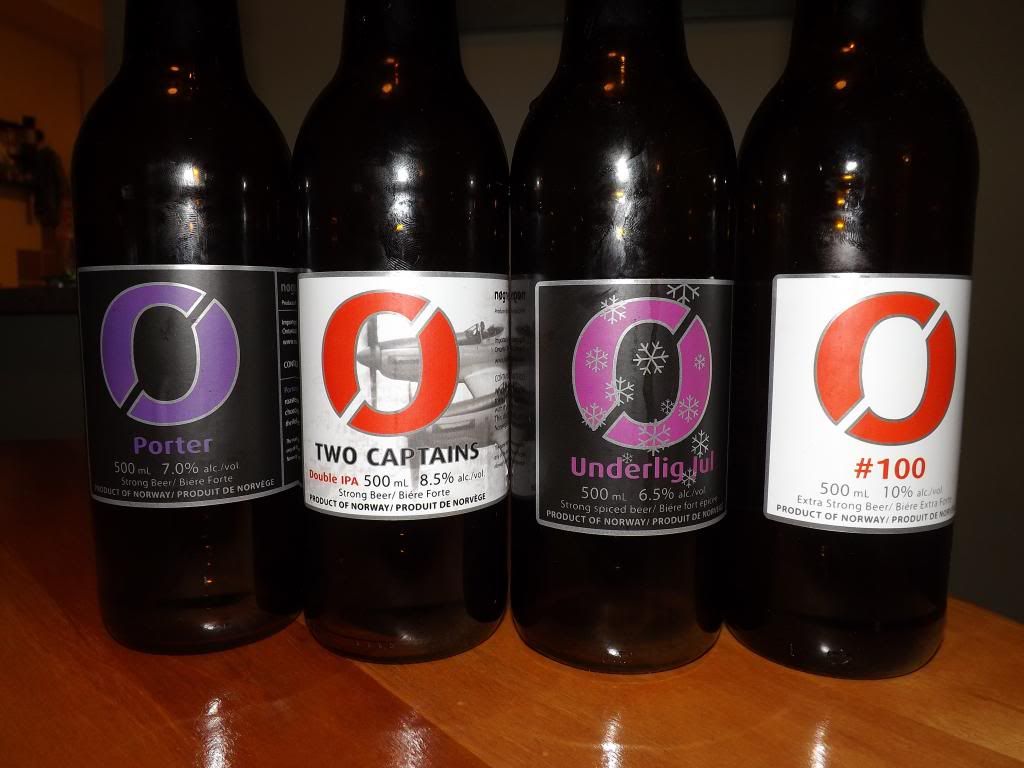
Actually, before I get going I should say this: I purposely left out one of the five brews of the release - Tiger Tripel - from the list for two reasons. First, I haven't heard terrific things about it so far, so I thought I'd spend my money elsewhere. The second reason is something I've been noticing lately, and will take a minute to address. As I talk to folks about the beer they like to drink, I've found that the Belgium Question has led to a pretty sharp divide, with a large number of people saying they can't get enough of the taste of Belgian-style brews, and an equally significant proportion claiming that they can't stand the stuff and won't go near it. My wife is that way when it comes to wheat beers - she just can't get over what she tastes as rotten wheat (she's right, of course, cause that's what it is), so all wheat beers are off the table for her. Another friend of mine can't stand the taste of grapefruit, so American hops are rarely his thing. Others are the same way about Belgian beers, and it probably comes down to the unique yeast and associated esters that are featured in most Belgian brews; ergo, if you don't like that yeast and what it does to the beer, you won't like most Belgian beers. For the longest time, I've been sitting in first-class on the Belgian Love Train, and have happily snapped up any beer remotely related to that great brewing nation that I can. However, in recent months, I've found my tastebuds have shifted somewhat, or at least become more confident in what they like and what they don't. Because of this, I find that more often than not Belgian ales just aren't doing it for me. I'm not sure if it's the yeast or the higher carbonation levels or some of the esters there, but I've been on a bit of a Belgian funk recently, no pun intended. Don't get me wrong, I still love many Belgian brews and haven't written off the styles whatsoever; I just find that I'm pickier about them than I used to, so I'll save my reviews for those that I really like and won't deter the rest of you from trying something that I didn't like simply because the style no longer appeals to me. Tastes change, and yours might as well. I just look at it like I'm fine-tuning my beer radio dial to the style stations I like the best.

Back to it!
Beer: N
øgne
Ø Porter
Type: English Porter
ABV: 7%
First off the mark is the porter, which is done in the English style with a bit of American hops (Centennial). It's a dark, cold day, so I figure a hearty porter is just the trick.
Poured into a nonic glass. Dark and thick as it should be, with a thick, sturdy head of off white foam. Great lacing. Stellar-looking porter.
Nose is rich and roasty, with some vanilla sweetness and some dark fruit (currant or blackberry). Some dry chocolate as well.
If well-roasted, slightly dry porters are your thing, you are in for a treat here. The bitterness of the roasted malt really dominates the brew, but it has company in the form of that dark fruit and lingering sweet vanilla. Long bitter finish, dry, and with a touch of hops. Very nice, hearty brew. Somewhat thick, not so much so that it enters into stout territory, but it's close. Feels like a porter - creamy, medium bodied, light carbonation.
Picks right up where the imperial stout left off last year. Very dependable porter. (Grade: A-)
Beer: #100
Type: American Barleywine
ABV: 10%
With a name like #100, you'd expect this to be their 100th beer. It totally is. No secret links to Norwegian history here, at least as far as I can tell, though somewhere I did read that this is supposed to be a reference to the 100th anniversary of Norway's independence from its union with Sweden in 1905, the website simply states that this brew was their 100th batch. But it could very well mean both things. Get used to this from N
øgne
Ø. Apparently, this was just supposed to be a one-off celebration beer, but demand was high enough for it that they made it a regular offering.
Poured into a Belgian ale goblet. Dark chestnut in colour, with a bit of amber highlighting. I've been running into more of the darker barleywines recently, so the colour shouldn't be that much of a surprise, and yet I still find it strikes me as being a bit off. Their ingredients online list chocolate malt as being part of the mash, so there you go. No matter, it still looks fine. Pour yields a good half inch of froth that holds up well and brings up a great deal of lace.
Nice combination of smells here that are certainly quite pleasant, though difficult to pin down. There's the sweet malty blast of a typical barleywine, chocolate malt, some smoke, raisins, resin and citrus hops, and bubblegum or some other sweet candy.
A little on the boozy side, but that's to be expected. Quite enjoyable, lots going on here. I think this is a brew that is totally up to personal interpretation; well, all beer is up to interpretation, but some brews are easier to unpack than others, and this one is complex enough that some people will smell certain notes, and others will get something else entirely. I for one happened to get two R's - raisin and resin - above all other subtler flavors, swimming in a sweet and boozy malty base. There's also some spice - cinnamon, maybe ginger? Complex and tasty, no doubt about that. Good crisp carbonation, warmth from the booze, medium bodied, somewhat creamy.
A solid barleywine, with lots going on to keep the tastebuds and nasal cavities well occupied. Glad they kept this one on regular lineup. (Grade: A-)
Beer: Two Captains
Type: Double IPA
ABV: 8.5%
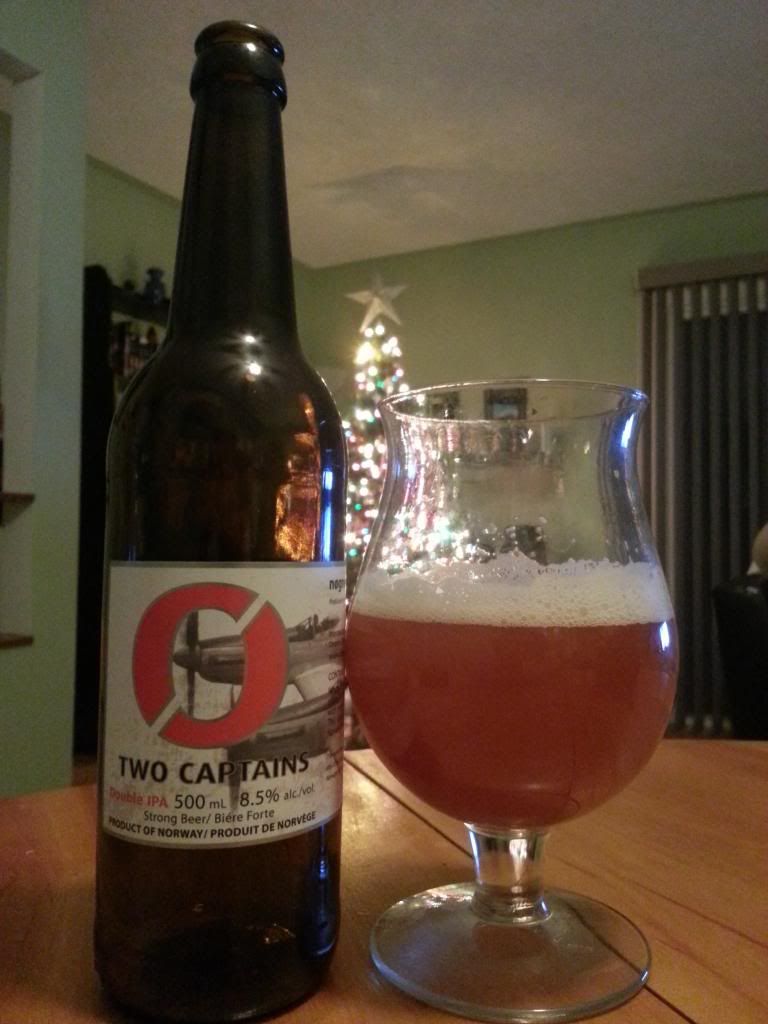
Again with the double-meaning behind the beer's name. Two Captains could refer to the Mustang plane on the label, which is an F-82 Twin Mustang - two planes fused together. Since there are two cockpits, there are also, in effect, two captains. The idea behind this plane was to allow for longer-ranged flights during the early years of the Cold War; with two pilots behind two engines, the planes could be flown for longer (one could fly while the other could rest). However, this also could refer to the fact that the brew came about because of the efforts of a Norwegian homebrewer, who came up with the recipe, and the N
øgne
Ø brewmaster, who brewed it. Both of these men were once captains piloting for Scandinavian Airlines. It works either way - double plane/double pilot for double IPA.
Back to the goblet for this brew. I have to say, in terms of appearances like the double Mustang on the front label, this brew just...didn't look right. A murky peach-caramel colour, with a decent half inch of foam that rests stubbornly on the surface, creating some nice lacing. The real problem here was some ugly chunks of sediment floating around the bottom of the glass like those gross bubble sodas from the 1990s. Orbitz, I think they were called. I know that sediment is a common feature of many a strong brew, and I know that it's there to give the brew a possibility of some extra bottle conditioning, but this one just looked unappealing, so I ended up filtering it out.
No matter, the brew smelled and tasted just fine. All double IPA to the nose: fruity, nice pine and resin hop base, with mango, orange peel, and malty caramel sweetness. Tasted quite similar with nice fleshy fruits (mango, peach, orange) and bitter, citrus/resin hops. Pine hops to the finish. Could be a bit hoppier, but there you go. As I've said many times before, double IPAs are tricky characters that could just as easily be classified as American barleywines. This one leans more towards the latter, which is fine with me, though I'd just as easily take a stronger hop bomb. Either way, appearance aside this is also a fine brew. (Grade B+)
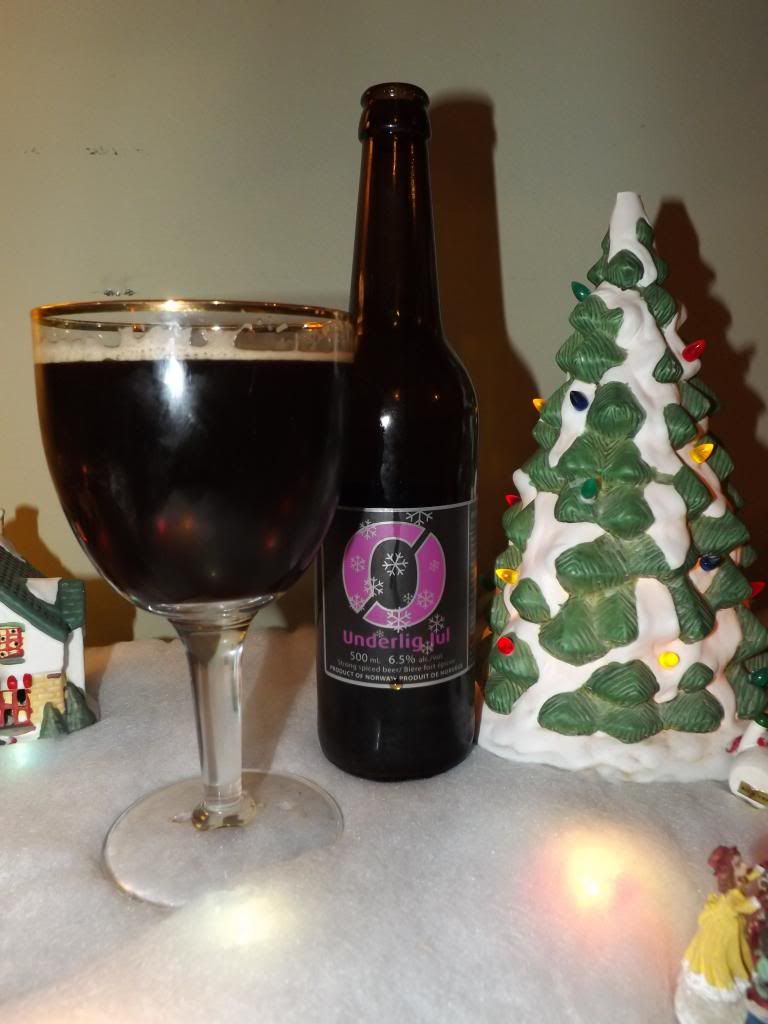 |
| What is this, a beer for giants? |
Beer: Underlig Jul
Type: Christmas Beer? I guess?
ABV: 6.5%
Sorry again for the crap photos - my cameras (good one and cell phone one) still can't take great evening pictures with low light. Either it doesn't focus with no flash on, or the flash obliterates everything in sight. If anyone has any good suggestions for how to fix this, I'd love to hear it, because we've got about four months of cold and dark ahead of us.
Underlig is Norwegian for "Peculiar", and since this is a winter brew, I'll leave you all to figure out what "Jul" means. Unlike other winter brews that more or less take the standard pale ale or IPA and add some spices to it (not that there's any problem there!), Underlig is a brew that, of our list, is perhaps the most uniquely Norwegian. The idea here was to brew something that tasted like a glass of
Gløgg, a Nordic drink that we in Canada call "mulled wine." So there will be lots of spices, but with a particular focus on those herbs and spices that normally would go in a glass of Gl
øgg.
Another goblet for this one. Dark brown with a hint of ruby around the edges, and with a fluffy head of foam that recedes into a thick ring with some lacing.
Once you open the bottle, a blast of herbs greets you - really opens up your sinuses, actually. The bottle lists cinnamon, ginger, cloves, coriander and - perhaps most strangely - cardamom as being added spices to the mix, and I'll certainly say that the ginger gets top billing here. Peppermint, herbal medicine (cough drops?), orange peel are also in the mix. A spicy conglomeration, this. Really gets you in your sinuses, but in a good way.
This is actually the second bottle I've had of this, and the first one was not a success (the general consensus was "too much like medicine"). I think the problem with this was that we had prefaced that beer with two hearty imperial chocolate stouts, so the change was pretty damned drastic. Consumed on its own and with the whole bottle to myself, I can certainly see the medicinal quality to the brew, but I have to say there's a lot more to it than that. The first few sips are quite strong in the ginger, peppermint and herb department, but as your tastebuds acclimatize, things become far more balanced. The Christmas flavors of cinnamon, oranges with clove, and sweet malt start to get some time to shine. As you go further along, the hops (American, again) start to become more assertive, giving the brew a nice pine woodsy feel and also cleansing the palate of the rich heaping of spice. Really interesting beer this, and the more I sip it, the more I'm enjoying it. Medium bodied, generously carbonated. (Grade: B+)
Good showing from the largest craft brewery in Norway. Most of the brews are of a style that is easily found in the US, but I always give immense credit when good styles are done well, and these are certainly up there, with bonus marks for the porter, a style that is often overshadowed by its stouter brother. For sheer originality and sense of Norwegian-ness, I have to give the credit to the Christmas Underlig Jul ale, but all the brews had their own charm. I was able to find these in Kitchener without too much trouble, and at around $6.50 per bottle, they aren't beyond the realm of the reasonable in terms of price. Might be a nice Christmas pickup.
God Jul to the folks at N
øgne
Ø!
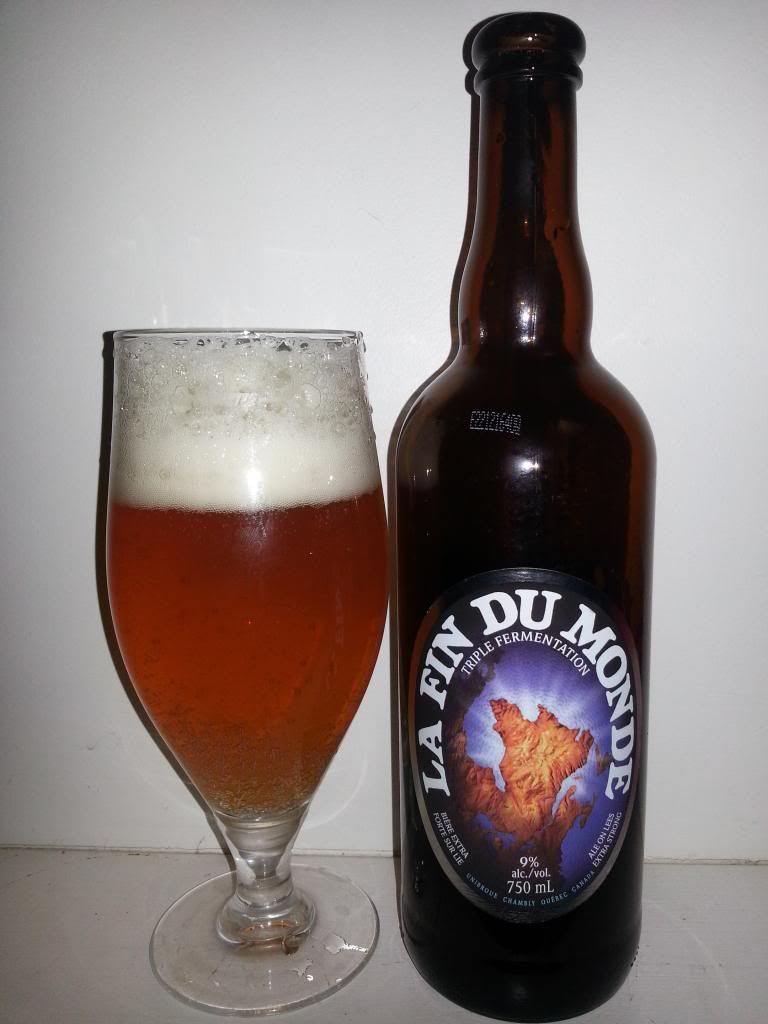

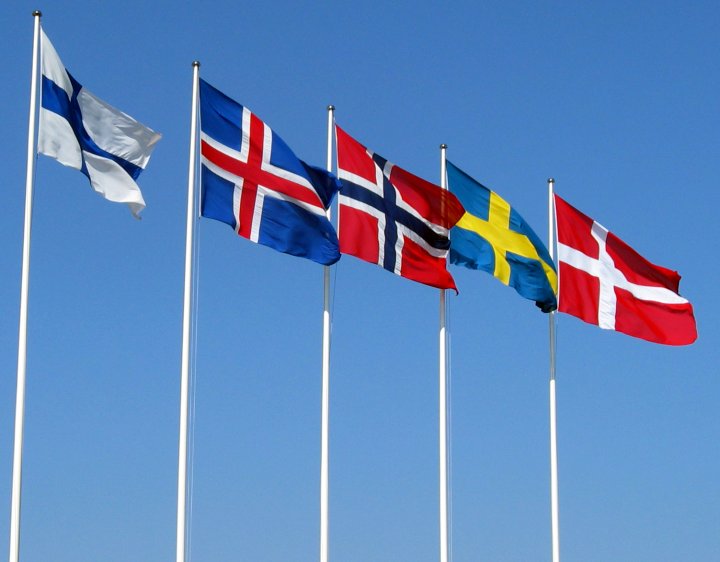


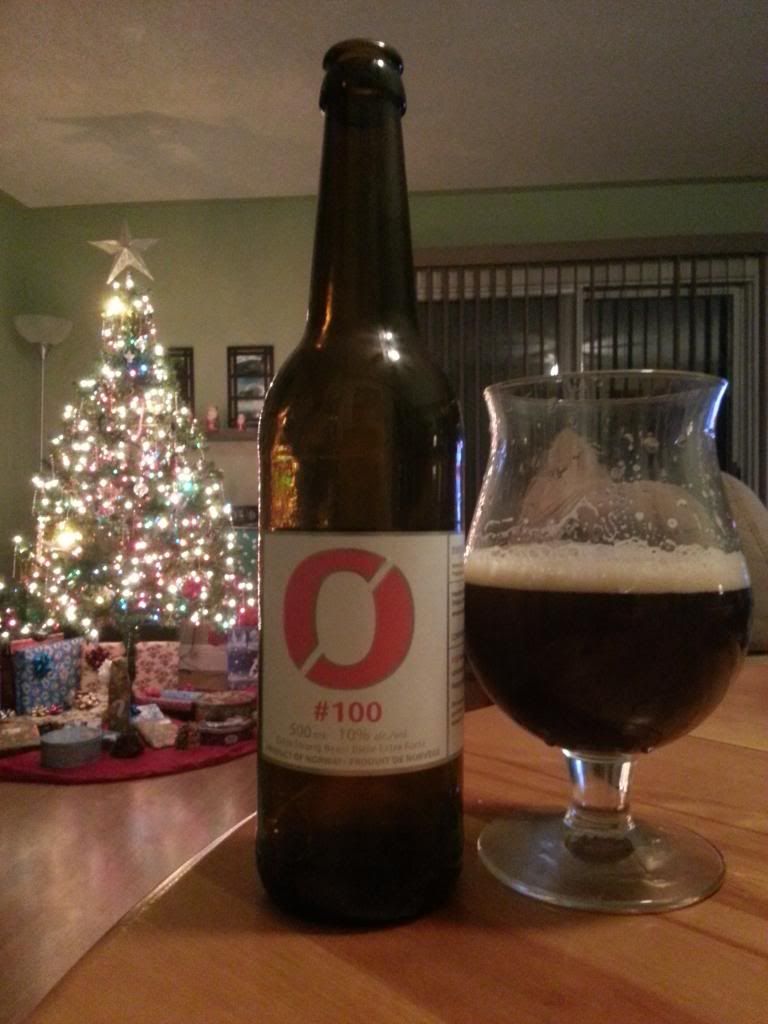


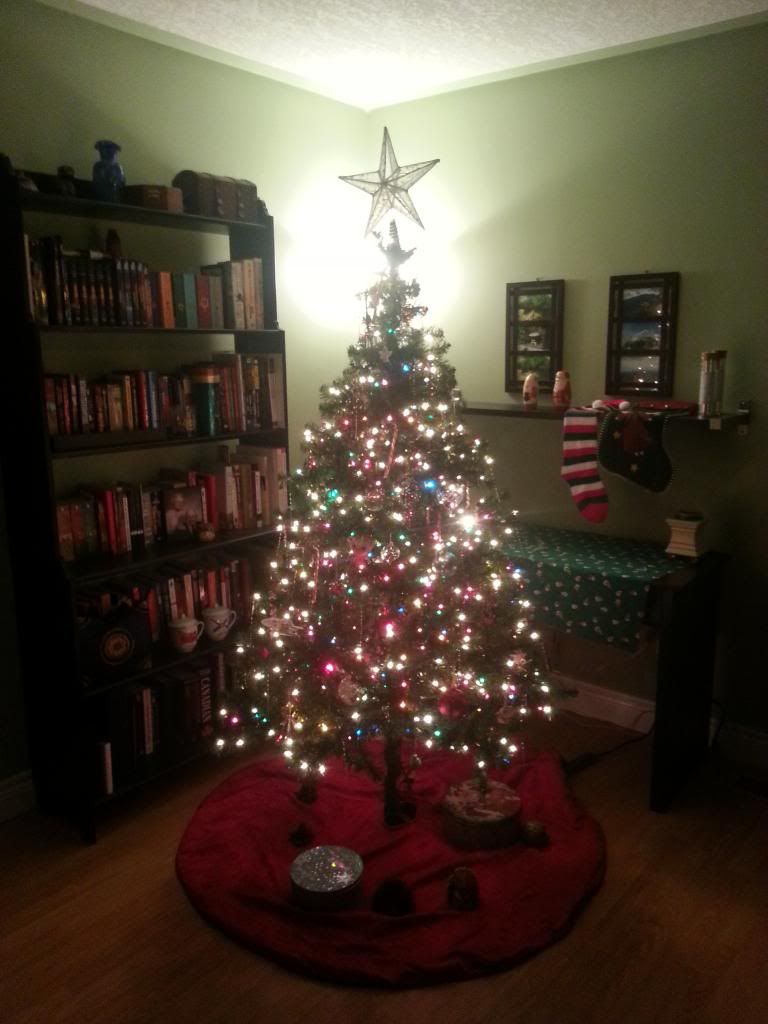
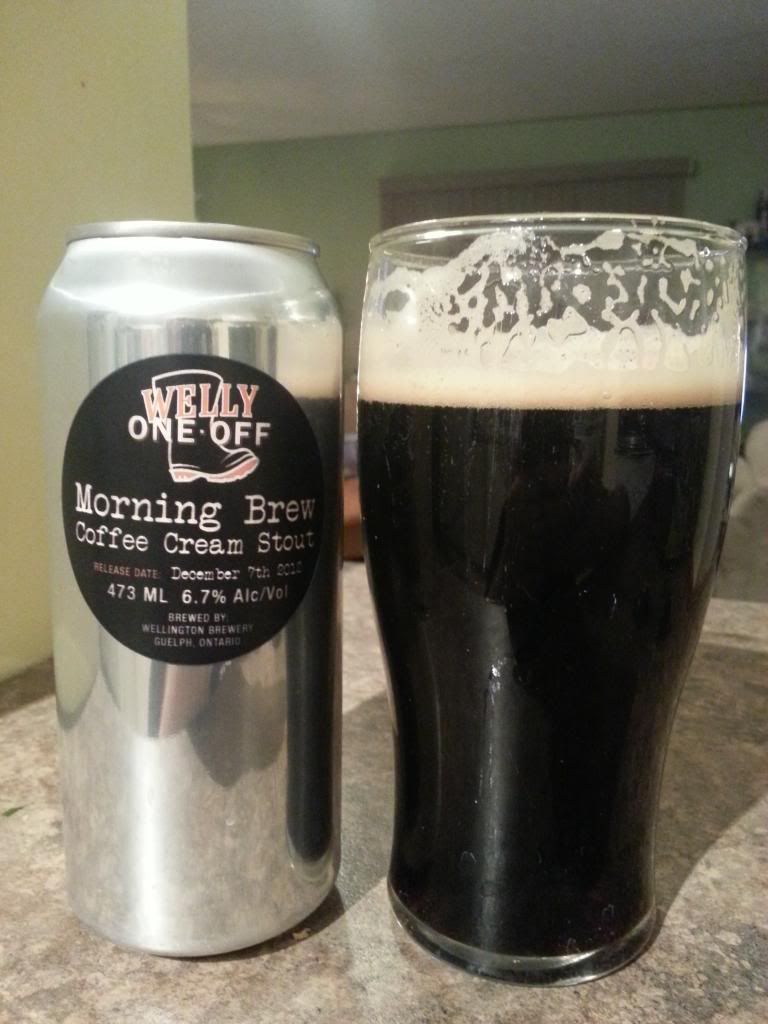
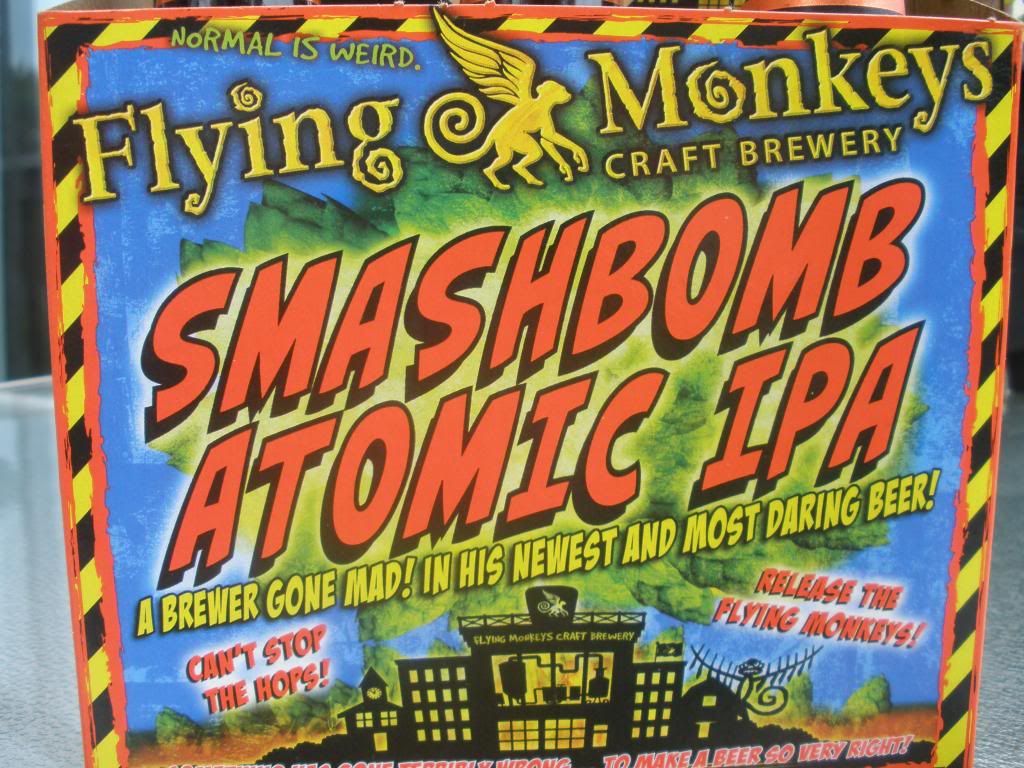

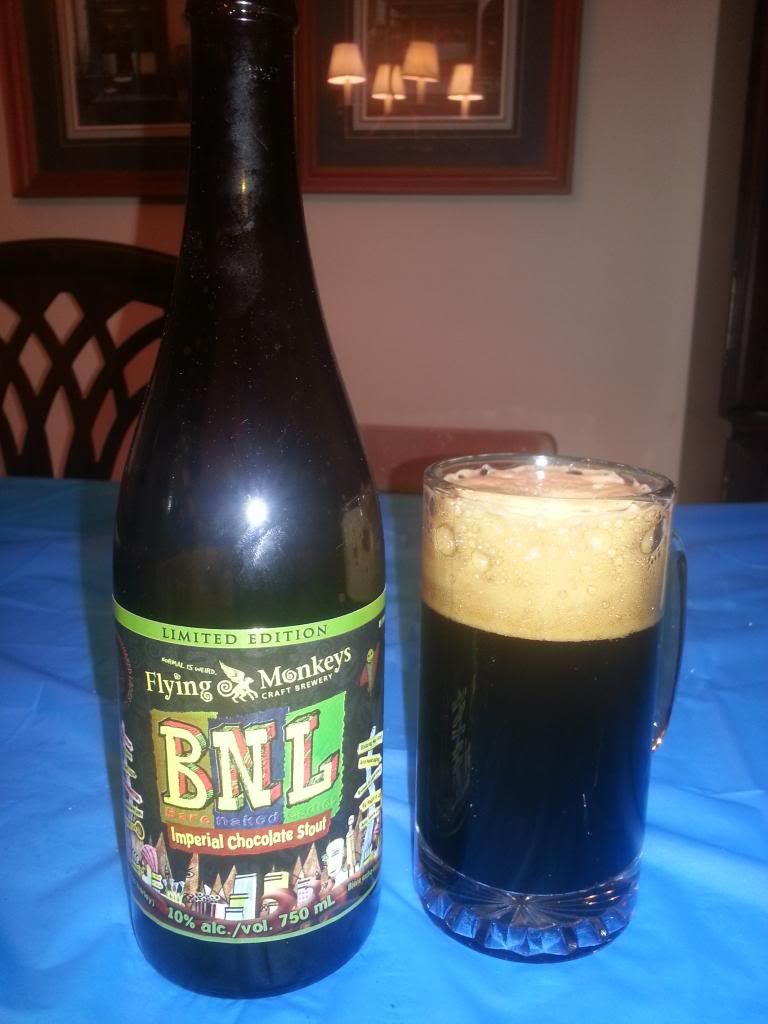



.JPG)
.jpg)